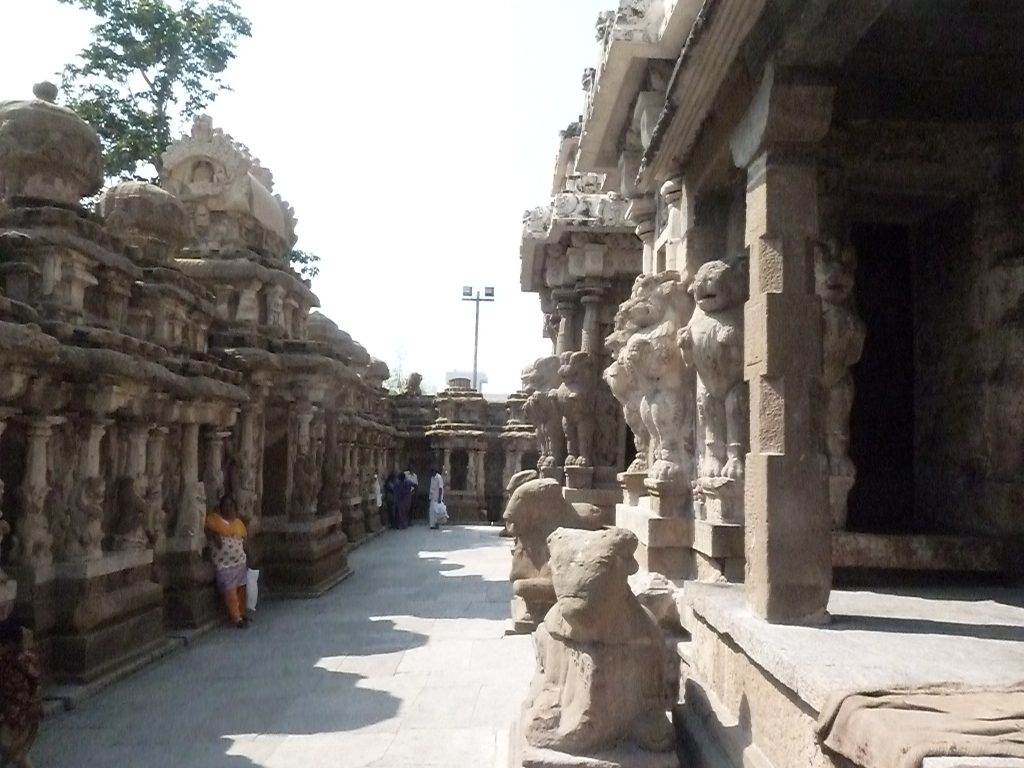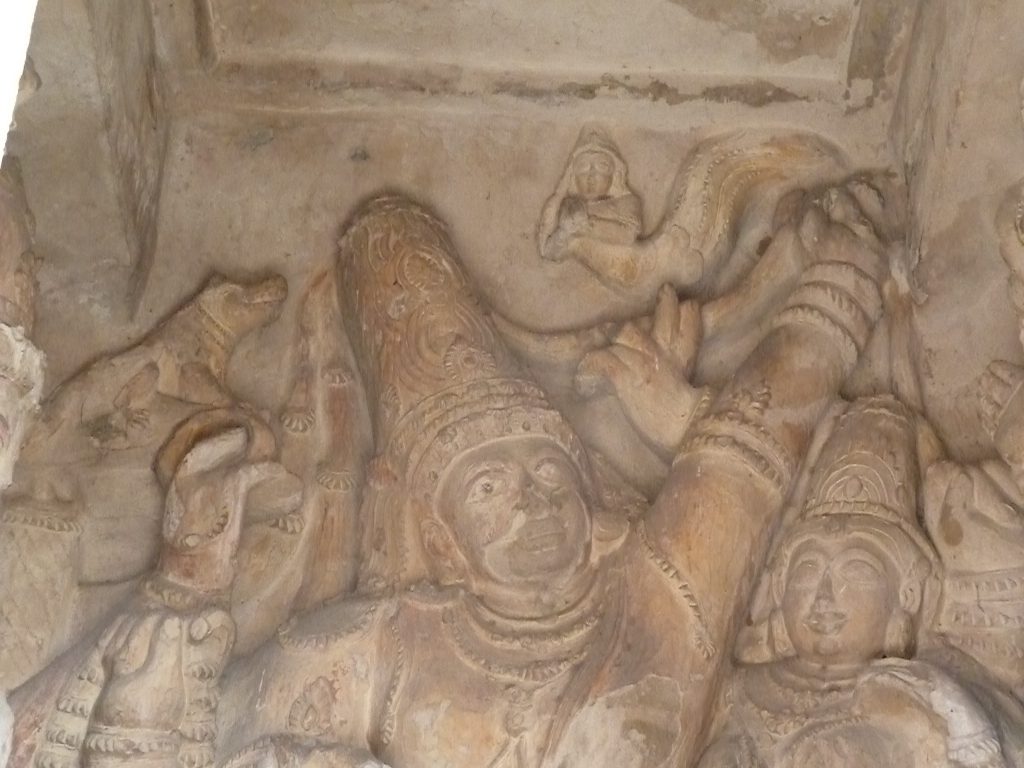
Kanchipuram is one of the holiest and most sacred cities in India (Jayapal & Amiratham 239). It is branded for being a temple city, home to the Kailasanatha temple, Vailkunta Perumal temple, Varadharaja temple, Kamakshi Amman temple and many others (Jayapal & Amirtham 242). During the 3rd to 9th century C.E., the Pallava Dynasty ruled South India from Kanchipuram, during which king Rajasimha built the Kailasanatha temple (Rao ed al. 594). Hinduism in South India was developed by the Pallava dynasty by building temples to worship the gods and devote to the gods (Rao et al. 595). Kailasantha temple is dedicated to Lord Siva, which honours Siva’s mountain home, Mount Kailasa (Dehejia 200). The temple is known for its Dravidian style architecture, the design mainly used for temples across South India. Most temples in the south are dedicated to specific deities and Rajasimha’s admiration for Siva was what led Kailasantha temple to be a Siva devoted temple.
In India, dynasties frequently changed, each one was conquered by another. Thus, over time, when new rulers would come into power they would build temples, monuments, caves, etc. that reflected their own political power and authority (Jayapal & Amirtham 240). The Kailasanatha temple was built during the time of The Pallava dynasty, more specifically when king Rajasimha was in power and used the Shore Temple in Mahabalipuram as inspiration. Kailasantha temple is known for its stone foundation and sandstone framework. A major influence on the design of the temple was based upon “dimensions of the heavenly land – lord of the cosmic mountain” (Jayapal & Amirtham 242). Therefore, the Kailasanatha temple is considered to be one of the oldest temples that exist today amongst the many temples in Kanchipuram.
Dravidian style architecture/temples are very distinctive from Northern India. The shapely design of the sikhara or ‘peak’ differ between the two architectural structures. The sikhara of southern (Dravida) temples/architecture is that you can discriminate between all of the arising horizontal levels whereas in northern (Nagara) temples/architecture they are typically masked (Dehejia 207). The outside walls of Nagara temples typically feature many female figurines, couples, and/or erotic imagery compared to Dravida temples which emphasize the importance of deities and may mention kings, saints, and legendary devotees (Dehejia 207). Before stone carving was introduced, most temples were built using deteriorating brick, lime, wood, and metal materials (Jayapal & Amirtham 240). The stone-carving technique in the South compared to western India was not a well-established technique therefore less familiar. A rationale for why stone may have taken its time before being embedded into their structures is “because the South had first to disassociate it from the funerary connotations acquired in an area where ancient megalithic tomb cultures had once prevailed” (Dehejia 185).

Before the Pallavas were known for their Dravidian style architecture and their greater influence on stone-carving in the South, there were the Chalukyas. The Chalukyas mimicked their rock-cut temples to the stone mountains of Siva and Visnu, such as, Kailasa or Vaikuntha [celestial abode of Visnu], where the rock forms the temple’s foundation and peak or sikhara, similar to that of the Kailasantha design. The earliest of the stone temples in South India are considered to be constructed by the Early Western Chalukyas (Tartakov 39) and the edifices of Early Western Chalukyas are also considered to be some of the earliest forms of Dravidian style architecture (Tartakov 95). The third successor of the Pallavas, King Mahendravarman, was the first Pallava to experiment with the rock-cutting technique, going on to cut his first cave and several others thereafter (Dehejia 185). Some scholars think that the style that was established by the Pallavas may have been taken in by the Chalukyas during the reign of Vikramaditya II. Other scholars that believe Chalukyas established the Southern style and then the Pallavas adopted it (Tartakov 96). One scholar’s point of view is that the octagonal, rectangular, and apsidal sikharas in the South were created by the Pallavas, but the square dome variation was built by the Chalukyas (Tartakov 97). Some characteristics that set the Pallavas art/architecture from the Dravidian style of the Chalukyas is that there is no figurative imagery in ceiling panels, the doorways do not use prastara hara, or entablature garland, nor do they incorporate the use of lalata bimba or block in lintel’s center [this is to just name a couple of the important stylistic characteristics of the two dynasties, there are more features that set them apart to help distinguish between the two Dravidian style imagery] (Tartakov 98).
The Kailasanatha temple is oriented from east-west, is held together within a rectangular enclosure wall and contains a sandstone shrine. The pyramidal scheme, or sikhara, shows us the development of it from the Dharmaraja ratha and the distinctive feature of Southern temples (Dehejia 200). Upon entering, there is a “compact, barrel-vaulted, rectangular shrine built by Rajasimha’s son, Mahendra,” once you walk past the entrance there are “eight miniature shrines,” and near the front of the temple is sculpture of “Siva’s bull seated within, facing the Lord” (Dehejia 200-202). The miniature shrines that cover the courtyard walls are further broken down into east and west walls and north and south walls. The east and west walls contain images of Somaskanda, an image of Siva with his consort and son Skanda; the north and south contain interior images including Siva’s family group or Uma on her own, and “a shallow niche on their façades to accommodate further images” (Dehejia 202). The images are placed strategically where the south facing wall entails images of Siva as a destructive force and the north wall shows Siva in his benevolent form. Another feature of the temple is in the courtyard shrine along the bases, there are over 250 titles, or birudas, for Rajasimha, which are written four times on four separate levels of the building using various script styles (northern, southern and florid) (Dehejia 202). These birudas are meant to reveal the characteristics of how a model ruler should act when in political power. The titles or birudas at Kailasanatha temple written to celebrate Rajasimha. A few examples of the titles are, “He is the Ocean of Arts or Kala-samudra; Storehouse of Arts or Kala-nidhi; Sole Hero or Ekavira; Victor in Battle or Rana-jaya; Unconquered or Aparajita; Devastating in Battle or Atiranachanda; He who Showers Gifts or Dana-varsa” (Dehejia 202).

Kailasanatha temple is known for its sole dedication to Lord Siva. The temple contains a main shrine, which is home to an eight-foot-tall Siva linga, and seven connected sub-shrines, which surround the outside of the main shrine. The main shrine contains important images of Siva, some of which are ten feet tall. One of these images shows a dancing Siva in the form of a beggar, who ended up slaying demons and was given the Ganges (Dehejia 200). The temple houses a few figures of Siva including Siva seen “defeating death (Kalarimurti),” “Siva as the Supreme Teacher (Daksinamurti),” and another one where he is seen “riding into battle (Tripurantakamurti)” (Padma 51-53). Inside the towered shrine, or vimana, the linga is placed in the centre along with other temples across South Asia that are dedicated to Siva (Padma 50,53). Alternatively, Padma (2005) suggests that the Kailasanatha temple is an adjoined temple dedicated to Siva and a goddess. It consists of the Kailasanatha vimana or “towered shrine” which is dedicated to Siva and the Kailasanatha prakara “rectangular precinct wall” which is dedicated to a goddess. While sexual imagery is not ideal amidst Dravidian architecture, it is argued that “sexual metaphor is one of the many layers of meaning in the forms of the Kailasanath temple complex” (Padma 54). Padma describes the prakara as a goddess temple, comparable to a yogini temple where “it embraces a symbol of Siva in its courtyard as the yoni or vagina embraces the linga or phallus in heterosexual intercourse” (54). Although, the endless number of images and figures of Siva across the temple allow for scholars to agree with the popular thought, that the Kailasanatha temple is solely dedicated to the deity.
The importance of Kailasantha temple is that it is considered to be a personal chapel of King Rajasimha. He was able to devote his time into constructing temples because there was little of conflict during his reign. Its stone structure has allowed it to withstand centuries, with some corroding due to environmental factors, thus making it a significant structure to preserve. The design of the Kailasantha temple was a setting stone for the development and evolution of the Dravidian style architecture which may have influenced many temples that were built there after in South India. In Dehejia (1997), it is stated, “We can see the unmanifest in the linga and the manifest in the anthropomorphic images both in the sub-shrines and in the many aedicules along the temple walls” (200). This tells us that even though Siva is worshipped and seen as a phallic object, the figures/images of Siva gives us a thought or feeling to hold on to.
References
Dehejia, Vidya (1997) Indian Art. New York: Phaidon Press Limited.
Jayapal, Deepalashmi & Amirtham, Lily Rose (2016) “Conserve, Preserve, and Rejuvenate Architectural aspects of Kanchipuram.” Procedia – Social and Behavioral Sciences 225:239-246. Accessed October 25, 2018.
Kaimal, Padma (2005) “Learning to See the Goddess Once Again: Male and Female in Balance at the Kailāsanātha Temple in Kāñcīpuram.” Journal of American Academy of Religion 73(1):45-87. Accessed October 9, 2018.
Ed. Rao, K.L.S. & Ed. Kapoor, Kapil (2013) Encyclopedia of Hinduism. San Rafael: Mandala Publishing.
Tartakov, Gary Michael (1980) “The Beginning of Dravidian Temple Architecture in Stone.” Artibus Asiae 42(1):39-99. Accessed on October 9, 2018. doi:10.2307/3250008.
Related Topics for Further Investigation
Siva
linga
Mount Kailasa
Maha Shivratri
Pallava Dynasty
Shore Temple Mahabalipuram
History of Kanchipuram
yoginis
Nagara Temple
The biruda
Noteworthy Websites Related to the Topic
http://www.transindiatravels.com/tamil-nadu/kanchipuram/kailasanathar-temple/
http://www.kancheepuramonline.in/city-guide/kailasanathar-temple
https://en.wikipedia.org/wiki/Kanchi_Kailasanathar_Temple
Article written by: Manvir Jadir (November 2018) who is solely responsible for its content.